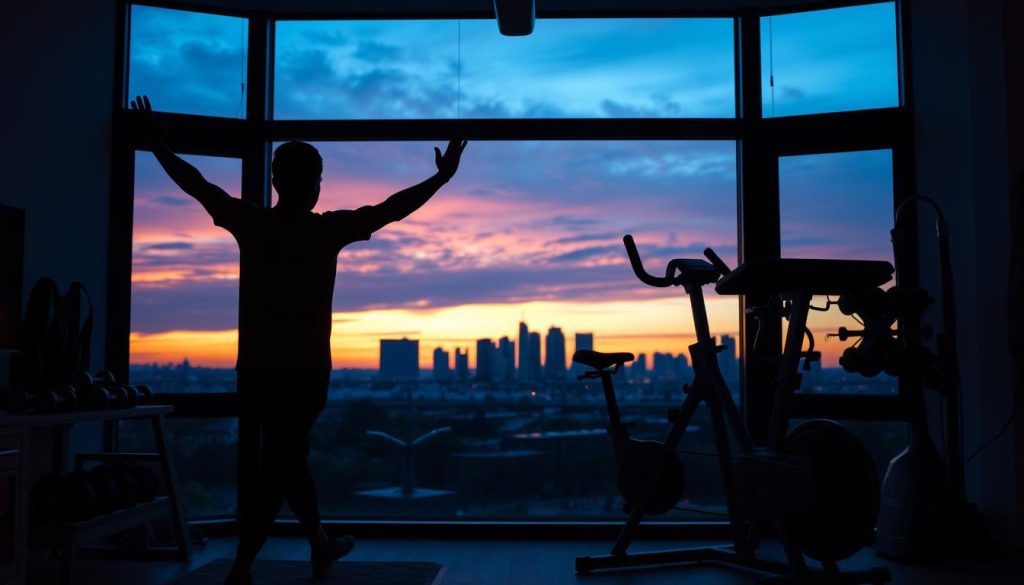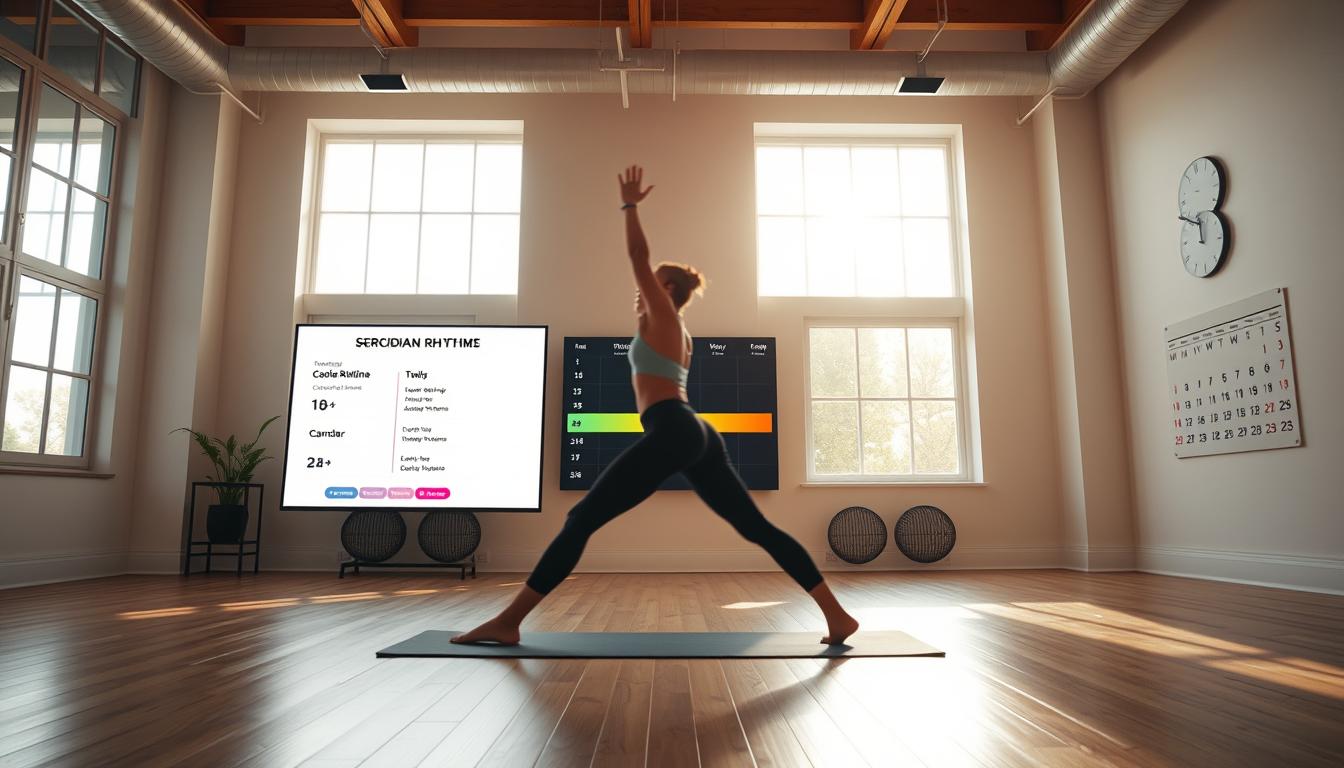Adjusting your workout schedule to match your body’s natural rhythms can boost your fitness. Understanding how your body’s internal clock affects your workouts can lead to better performance and recovery. This is key to reaching your fitness goals.
Studies show that exercising at the right time can make your workouts more effective. Experts say that matching your workouts to your body’s internal clock is crucial for health. This approach can help you meet your fitness targets more effectively.
Understanding Circadian Rhythms and Their Importance
Our bodies work on a 24-hour cycle called the circadian rhythm. This cycle is key for managing sleep, metabolism, and hormone release. Let’s dive into what circadian rhythms are and how they control our body’s functions.
What Are Circadian Rhythms?
Circadian rhythms are natural cycles that last about 24 hours. They mainly respond to light and darkness. This internal clock helps us know when to sleep and wake up, and it affects our health.
How Circadian Rhythms Regulate Bodily Functions
The suprachiasmatic nucleus (SCN) in the hypothalamus is our body’s “master clock.” It works with other clocks in our body to keep everything in sync. This ensures our body functions work together smoothly.
Knowing how to time exercise with our circadian rhythm is important. Research shows that working out when our body is ready can boost performance. It can also improve energy, mood, and fitness.
The Science Behind Exercise Timing
Getting the timing right for your workouts can really boost your fitness. Your body’s internal clock, or circadian rhythm, affects how well you perform. Exercising at the right time can make your muscles stronger, more flexible, and last longer.
Biological Clock and Physical Performance
Your biological clock controls many body functions, like when you sleep and wake up, and even your body temperature. Studies show that exercising at certain times can use these natural rhythms to better your workouts. For example, exercising in the late afternoon or early evening is when your muscles are strongest and most flexible.

Hormones and Their Impact on Exercise
Hormones like cortisol and testosterone change throughout the day and affect how well you exercise and recover. Cortisol, which helps with energy and immune function, is highest in the morning. Testosterone, which builds muscle and strength, peaks in the afternoon and early evening. Knowing when these hormones are at their best can help you plan your workouts for the best results.
| Time of Day | Key Hormonal Activity | Optimal Exercise Type |
|---|---|---|
| Morning | High Cortisol | Cardio, Aerobics |
| Afternoon | Peak Testosterone | Strength Training |
| Evening | Lower Cortisol, Moderate Testosterone | Flexibility, Yoga |
Optimal Exercise Timing for Circadian Rhythm
Finding the best time to exercise can greatly improve your physical performance and overall health. Our body’s energy levels and hormonal balance are influenced by our circadian rhythms. These rhythms are key to how well we exercise.
It’s important to know when your energy is at its peak and trough. Your body’s core temperature is usually highest in the late afternoon to early evening. Exercising during these times can boost your physical performance and help muscles grow.
Also, consider how hormones affect your workout. Morning workouts can be good because of high cortisol levels. This hormone helps you stay alert and boosts metabolism. On the other hand, late afternoon and evening workouts are better because of higher testosterone levels. This hormone helps with muscle performance and recovery.
Listening to your body and exercising when you feel best is crucial. This way, you can enjoy and get the most out of your workouts.
Morning Workouts: Pros and Cons
Morning workouts can kickstart your day, but they also have challenges. Knowing the good and bad sides helps decide if morning exercise fits your goals.
Advantages of Morning Exercise
Morning exercise boosts your metabolism, helping you burn more calories all day. It also sharpens your mind, keeping you alert and focused.
Another plus is it can become a daily habit. This makes it easier to stick to, giving you a sense of accomplishment.

Potential Drawbacks of Early Workouts
However, morning workouts might not be perfect for everyone. They can make your muscles less flexible, raising injury risks. Your body’s lower temperature might also slow you down.
For those who don’t wake up easily, morning workouts can cut into sleep. This can mess with your body’s natural rhythm, affecting your overall health and activity levels.
Midday Exercise: Finding the Sweet Spot
Working out in the middle of the day is great because it matches our body’s natural rhythm. Our body temperature and hormone levels are at their best, making it perfect for intense workouts. This time is ideal for boosting physical performance and lowering injury risks.
Exercising at lunchtime also helps fight the bad effects of sitting too long. It can prevent poor posture and back pain. Plus, it refreshes your mind, making you more focused and productive for the rest of the day.
But there’s more to it than just physical health. Midday workouts can also lift your mood and improve your thinking. They release happy hormones and reduce stress. This makes it a great time to recharge and stay sharp in the afternoon.
In short, adding exercise to your midday routine is a smart move. It offers many benefits, from better physical performance to clearer thinking. This time is truly the best for those who want to get the most from their workouts.
Evening Workouts: How Late Should You Go?
Evening workouts have special benefits that can fit well into your daily life. They help with your body’s natural rhythm and fitness. Knowing how your body responds to exercise at night can make your workouts more effective.
Benefits of Evening Exercise
Evening workouts are great because your muscles are strongest and most flexible. After a long day, your body is ready for hard work. Exercise in the evening also helps you relax and get ready for bed.
Doing workouts in the evening can also improve your performance. Studies show that your endurance, strength, and speed might get better. This is because your body temperature and metabolism are at their best, matching your natural rhythm.

Potential Downsides of Late-Night Workouts
But, working out too late can also have drawbacks. It might mess with your sleep. The excitement and happiness from exercise can make it hard to fall asleep. This can hurt your sleep quality and rhythm.
Another issue is the energy boost you get at night. This can make it hard to wind down before bed. Finding the right balance between evening exercise and sleep is key for your well-being.
| Pros | Cons |
|---|---|
| Higher muscle strength and flexibility | Potential sleep disruption |
| Effective stress relief | Increased late-night energy levels |
| Better overall performance | Interference with bedtime routines |
Aligning Exercise With Circadian Rhythm
Finding the right time to exercise can boost your performance and health. By matching your workouts with your body’s natural rhythm, you can get the most out of your exercise. This approach leads to better health results.
Personalizing Your Workout Schedule
Creating a workout plan that fits your body’s rhythm is important. Morning folks might do best with early workouts, when they’re most energetic. Night owls, on the other hand, might find evening sessions more effective. Knowing your own rhythm helps find the best exercise time.
Tools and Apps to Aid Scheduling
There are many tools and apps to help schedule your workouts. Wearables like Fitbit and Apple Watch track your heart rate, sleep, and activity. They give insights into when you should work out. Apps like MyFitnessPal and Sleep Cycle offer personalized advice based on your data.
| Tool/App | Features | Benefits |
|---|---|---|
| Fitbit | Heart rate, Sleep tracking, Activity monitoring | Provides a comprehensive view of daily rhythms |
| Apple Watch | Heart rate, Sleep tracking, Activity rings | Encourages balance between rest and activity |
| MyFitnessPal | Diet tracking, Exercise logging | Helps track progress and syncs with other devices |
| Sleep Cycle | Sleep pattern analysis, Wake-up timing | Advises on best sleeping and waking times for exercise |
Using these tools can make it easy to fit exercise into your day. They help you follow a schedule that matches your natural rhythm.
Circadian Rhythm and Physical Activity: Real-Life Examples
Many athletes and fitness fans have seen great results by matching their workouts with their body’s natural cycles. This approach has improved their performance and health. Let’s look at some examples to see how it works.
Success Stories
Elite athletes like Michael Phelps and Serena Williams have made this approach work for them. They’ve timed their workouts to match their body’s peak times. This strategy has boosted their performance and led to great results.
Michael Phelps, for example, schedules his swim sessions when he’s strongest. Serena Williams has adjusted her training to fit her body’s natural cycles. This has helped her improve her agility and recovery.
Common Mistakes to Avoid
While following the circadian rhythm for exercise is helpful, there are pitfalls to watch out for. One big mistake is ignoring personal differences. Everyone’s best workout time is different, so it’s key to tailor your schedule.
Another error is not considering the time of year. Daylight changes affect our natural rhythms. Ignoring this can mess up your training. Research shows it’s important to be flexible and adjust your routine as needed.
Circadian Rhythm Exercise Research: What Studies Say
In recent years, the study of how exercise timing affects our bodies has grown. It shows that working out when our body’s clock says it’s time can boost performance and health. It also helps our bodies recover better.
Key Findings From Recent Research
Recent studies have found interesting things about exercise and our body’s clock. A study in the Journal of Physiology found that muscle strength and endurance are better in the afternoon and evening. This means that working out then might give you better results.
Another important study looked at how exercise timing affects our metabolism. It was published in Cell Metabolism. The study found that exercising at certain times can help control blood sugar and fat burning. This is good for weight management and overall health.
Future Areas of Study
The study of exercise and our body’s clock is just starting. There are many areas that need more research:
- Individual Differences: We need to understand how genetics affect our body’s clock and how it impacts exercise.
- Chronotherapy: We should look into how timed exercise can help with sleep problems, metabolic issues, and heart diseases.
- Technology Integration: We need to develop tools and wearables that give personalized exercise plans based on our body’s clock.
As research continues, we will learn more about how to use our body’s clock for better fitness. This will help us understand how to optimize our workouts for the best results.
Boosting Workout Efficiency Through Circadian Rhythm Fitness Optimization
Optimizing workouts with your body’s natural rhythm is becoming more popular. It helps make your exercise routine more effective. Changing the intensity and length of your workouts can really help.
Listening to your body’s natural rhythms can improve your performance and recovery. For example, doing intense workouts when you’re most alert, like mid-to-late afternoon, can lead to better results. Doing lighter activities when you’re less energetic helps keep things balanced.
What you eat also matters for your circadian rhythm and exercise. Eating carbs and proteins when your body can use them best boosts energy and helps muscles recover.
To see how circadian rhythm fitness optimization works, consider this:
| Time of Day | Suggested Activity | Reasoning |
|---|---|---|
| Morning | Light Cardio | Boosts metabolism and starts the day with energy |
| Mid-Afternoon | High-Intensity Training | Peak physical performance and alertness |
| Evening | Relaxing Yoga | Promotes relaxation and better sleep quality |
In conclusion, using your body’s natural rhythms in your workouts can change your fitness routine. Paying attention to your body’s cycles is essential for better health and fitness.
Practical Tips for Synchronizing Workouts With Circadian Rhythms
Knowing the best time to exercise can boost your workout’s effectiveness and health. Start by tracking your sleep with devices like Fitbit or apps like Sleep Cycle. A regular sleep schedule helps align your body’s natural rhythms with your fitness goals.
Notice your energy levels throughout the day. Are you most awake in the morning, or do you peak in the midday or evening? Tools like the Oura Ring can help track your energy. Over a few weeks, you’ll understand your unique rhythms.
Try different exercise times and see how they affect your performance and recovery. This way, you’ll find the best time to exercise that fits your lifestyle.
Save high-energy workouts for when you’re most awake. Use yoga or stretching during low-energy times. This approach improves your physical performance and health. Keep adjusting your schedule based on your body’s responses to different exercise times.

